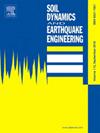Study on cumulative plastic deformation and resistivity-based damage evolution of frozen soil-rock mixtures under cyclic loading
IF 4.2
2区 工程技术
Q1 ENGINEERING, GEOLOGICAL
引用次数: 0
Abstract
The cumulative plastic deformation and damage evolution of frozen soil-rock mixtures under cyclic loading was studied by a dynamic triaxial instrument with real-time resistivity measurement function. A series of low-temperature cyclic triaxial tests were conducted under varying confining pressures (200 kPa, 500 kPa, 800 kPa), block proportions (0, 30 %, 40 %, 50 %), and dynamic stress ratios (0.4, 0.6, 0.8). The results reveal that the cumulative plastic deformation process can be divided into three stages, such as microcrack closure as the initial stage, crack steady growth as the middle stage, and rapid crack propagation until it fails as the final stage. Under the same number of cycles, the greater the dynamic stress is, the greater the cumulative plastic deformation is. Furthermore, a strong correlation is identified between the resistivity and the cumulative plastic deformation. With the increase of the number of cycles, the cumulative plastic deformation leads to the accumulation of internal damage, and the resistivity gradually increases. Thus, a damage evolution model based on resistivity damage variables is proposed. The model demonstrated an average fitting accuracy of 97.36 % with the experimental data.
循环荷载作用下冻土-岩石混合体累积塑性变形及基于电阻率的损伤演化研究
采用具有实时电阻率测量功能的动态三轴测定仪,研究了冻土石混合体在循环荷载作用下的累积塑性变形与损伤演化规律。在不同围压(200 kPa、500 kPa、800 kPa)、砌块比例(0、30%、40%、50%)和动应力比(0.4、0.6、0.8)下进行了一系列低温循环三轴试验。结果表明:累积塑性变形过程可分为微裂纹闭合为初始阶段、裂纹稳定扩展为中期阶段和裂纹快速扩展直至失效为最终阶段三个阶段;在相同循环次数下,动应力越大,累积塑性变形越大。此外,电阻率与累积塑性变形之间存在很强的相关性。随着循环次数的增加,累积塑性变形导致内部损伤的累积,电阻率逐渐增大。为此,提出了一种基于电阻率损伤变量的损伤演化模型。该模型与实验数据的拟合精度平均为97.36%。
本文章由计算机程序翻译,如有差异,请以英文原文为准。
求助全文
约1分钟内获得全文
求助全文
来源期刊

Soil Dynamics and Earthquake Engineering
工程技术-地球科学综合
CiteScore
7.50
自引率
15.00%
发文量
446
审稿时长
8 months
期刊介绍:
The journal aims to encourage and enhance the role of mechanics and other disciplines as they relate to earthquake engineering by providing opportunities for the publication of the work of applied mathematicians, engineers and other applied scientists involved in solving problems closely related to the field of earthquake engineering and geotechnical earthquake engineering.
Emphasis is placed on new concepts and techniques, but case histories will also be published if they enhance the presentation and understanding of new technical concepts.
 求助内容:
求助内容: 应助结果提醒方式:
应助结果提醒方式:


